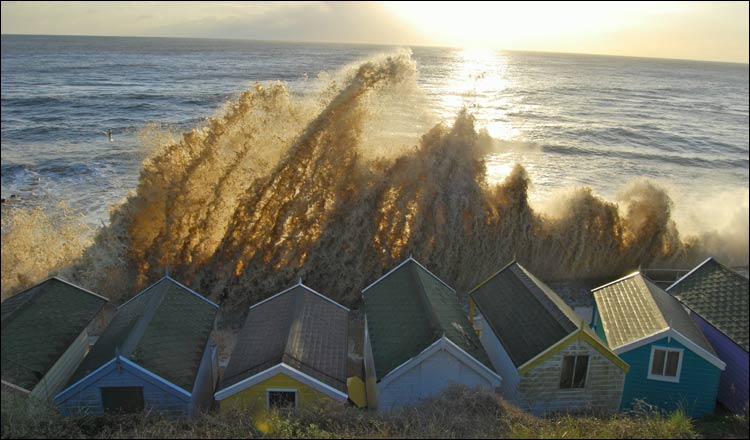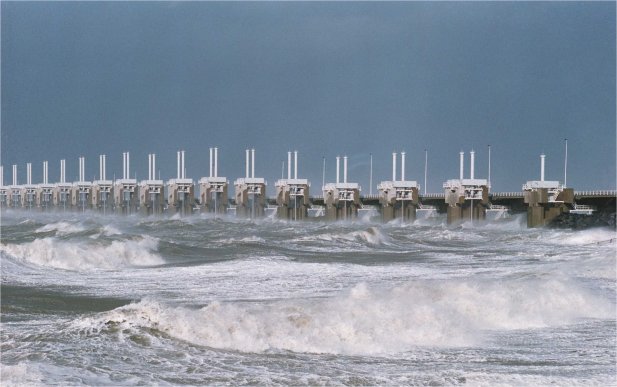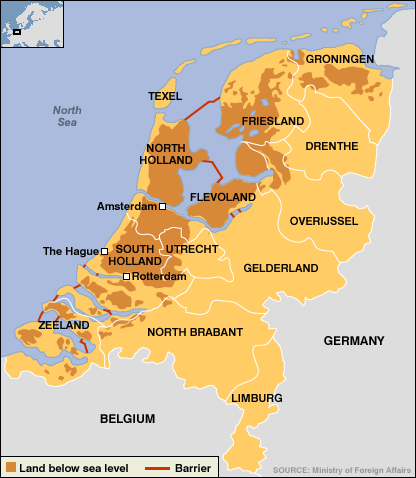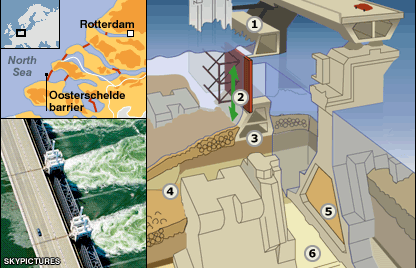
The Netherlands really dodged a bullet climatewise this past week. An unlucky confluence of tides, wind and low pressure was predicted to produce a storm surge comparable to the Great Storm of 1953. Luckily it wasn’t that bad and the defences held.
Although parts of East Anglia’s coast were inundated by the storm surge and wave of up to 20 ft high battered the Dutch sea defences, the worst didn’t happen. Phew. The surfers had a great time and none of Northern Europe’s major mercantile cities and ports were badly affected, though of course it did disrupt shipping and transport.

The largest swells were in Felixstowe, Suffolk, where sea levels rose to 2.84m (9.3ft) above average, and Great Yarmouth at 2.8m (9.2ft).
The water levels in Felixstowe and Great Yarmouth were the highest since 1953 when 307 people died after high tides and a storm saw a tidal surge of 3.2m (10ft 6in).
Though I’m sure those shovelling crap out of their living rooms in Norfolk this weekend don’t feel very lucky, it could have been so much worse. That it wasn’t a rerun of 1953, when there was no warning and huindreds died, when whole villages disappeared and thousands were made homeless overnight, is largely down down to luck and chaos theory. If the pressure had gone up or down a millibar, or the wind speed slackened or eased at the just the right moment, we could’ve all been swimming in seawater (or worse) this morning – or at least London and lhuge swathes of southeest England would have been.
The Dutch, (whose entire government system is based on the common management of water and land) sensibly closed the sea defences at the first sign of trouble:

They well remember 1953 and the devastation caused. These are the areas that would have been flooded during the storm surge, if it had not been for Dutch sea defences:

‘Sea defences’ sems such an inadequate word for the immensie series of constructed barriers that run almost the whole length of the coast closing off the North Sea from the flatlands. The huge Oosterchelde surge barriers that protect the islands of Zeeland, in the watery estuarine south:
1 Top beam, under which water flows when gates are open
2 Steel gate is lowered when sea level reaches “danger” height
3 Sill beam at foot of giant piers is embedded in sill
4 Sill comprises 5m tonnes of 10,000kg stone blocks, for stability
5 Voids in pier bases filled with sand after positioning
6 Synthetic “mattress” filled with sand and gravel laid on top of compacted sand to strengthen sea bed
The Oosterscheldebarrier is the biggest barrier and the most difficult to build: a 9km (5.6-mile) hydraulic wall with sluice-gate doors that are normally left open to protect the area’s delicate tidal habitat.
Another wall, the. Consisting of two hollow doors the size of the Eiffel Tower, the Maeslantbarrier, protects Rotterdam, the Netherlands’ second city with a population roughly the same size as that of New Orleans Maeslantbarrier was the Delta Project’s final instalment.
When it was completed in 1997, the total cost of the project amounted to more than $5bn.
The Dutch know that climate change is likely to flood the country, but where else is there to go? It’s a tiny coluntry, but that would still mean the evacuation of millions to other parts olf Europe. Hence the necessity for using all possible human ingenuity to protect the populace and keep it where it is, whatever the cost.
Contrast Britain’s long term flood policy: the Brown government, like Blair’s administration before it, has decided absent of any democratic input to just write off huge swathes of low-lying land in the south-east and elsewhere.
They are planning for what they see as inevitable inundation, whilst simultaneously pushing the Thames Gateway housing and development project which will concrete over marshes and put an additional homes onto one of the country’s largest floodplains, with apapently little thought given to beefing up the infrastructure to cope, this to house the many thousands of Eastern EU workers attracted by the honeypot of London.
The development of the Gateway, stretching from Canary Wharf in east London to the mouth of the Thames Estuary in Essex, forms an important part of the government’s strategy to build more housing in the south east.
Ministers have set targets for 160,000 new homes to be built in the Gateway between 2001 and 2016. The number of homes delivered has risen from around 4,500 in 1995-96 to 6,000 in 2005-06. But the rate of increase is below that of the rest of the greater south east. The NAO says: “The build rate will need to double from now on if the target is to be met.”
It’s a potential environmental disaster in the making, despite the new and improved Thames Barrier that’s also planned. I remember when the existing barrier was predicted to potect the Thames Valley for centuries to come. and here we are already, needing a new one.

This is what Britain would look like should the sea level rise as predicted, but. the Department for the Environment, Food and Rural Affairs’ plan is not to maintain many sea defences on the grounds that they are ‘uneconomic’.
If the British government is going to keep adding more and more people to the population it has to consider channeling development elsewhere than to the southeast. Are they really plannoing to build all this, to concrete over a flood plain and fill it with people, only for it to be flooded? It seems so.
The insurers’ report, Making Communities Sustainable, said that as many as 108,000 proposed homes in Ashford, Milton Keynes, the M11 corridor and along the Thames Estuary were located on flood plains and 10,000 of them were at significant risk of flooding.
In three of the areas, with the exception of the Thames Gateway, all the houses could be located above the flood plain with careful planning, but not in the Thames Estuary, where most of the development land was on flood plains.
The report warns the Government that it has much to do to keep up the flood defences around London. It said that some five per cent of sea defences were in poor shape but a much larger proportion of river defences needed attention.
Without the proper planning measures being taken and the advice of the Environment Agency being acted upon, a substantial number of them would flood at a cost of an extra £55 million in the annual flood bill for insurers, said the report..
I can’t make my mind up whether such an apparent policy disconnect is deliberate – make as much money as you can out of the area before it’s too late and screw the consequences – or just horribly ignorant of science and common sense, a combination which has become a hallmark of this Labour regime. How can it continue to overdevelop the southeast, while at the same time planning long term to give the region (ironically for an area so water-poor) up to the sea? The insurers’ association says ‘the flood risks in the growth areas could be managed effectively.’ The question is, are they?
That remains to be seen.
Call me cynical but when so many people so close to government have so much, in terms of career and financial investment at stake in the Thames Gateway development they’re unlikely to let a little thing like a potential ecololgical disaster to get in the way.
The Dutch? Not so much. I know where I feel safer, despite being below sea level.

bjacques
November 14, 2007 at 7:24 amYeah, that was pretty scary. As bad as the VVD have been (worse than the CDA), they’re not stupid enough to piss away the country’s water defenses for a quick buck.
I think a catastrophic flood would be a win-win for New Labour because they could declare a state of emergency and bring in further anti-terror laws, maybe get the national ID through for real (to distinguish HM subjects from illegal terrorist dole-fiddling fish).
Palau
November 14, 2007 at 3:02 pmOne theory is that New Labour, like Bushco, is putting all those laws in place to deal with the inevitable mass human migrations when the climate goes to shit.
I think there’s some truth to that.